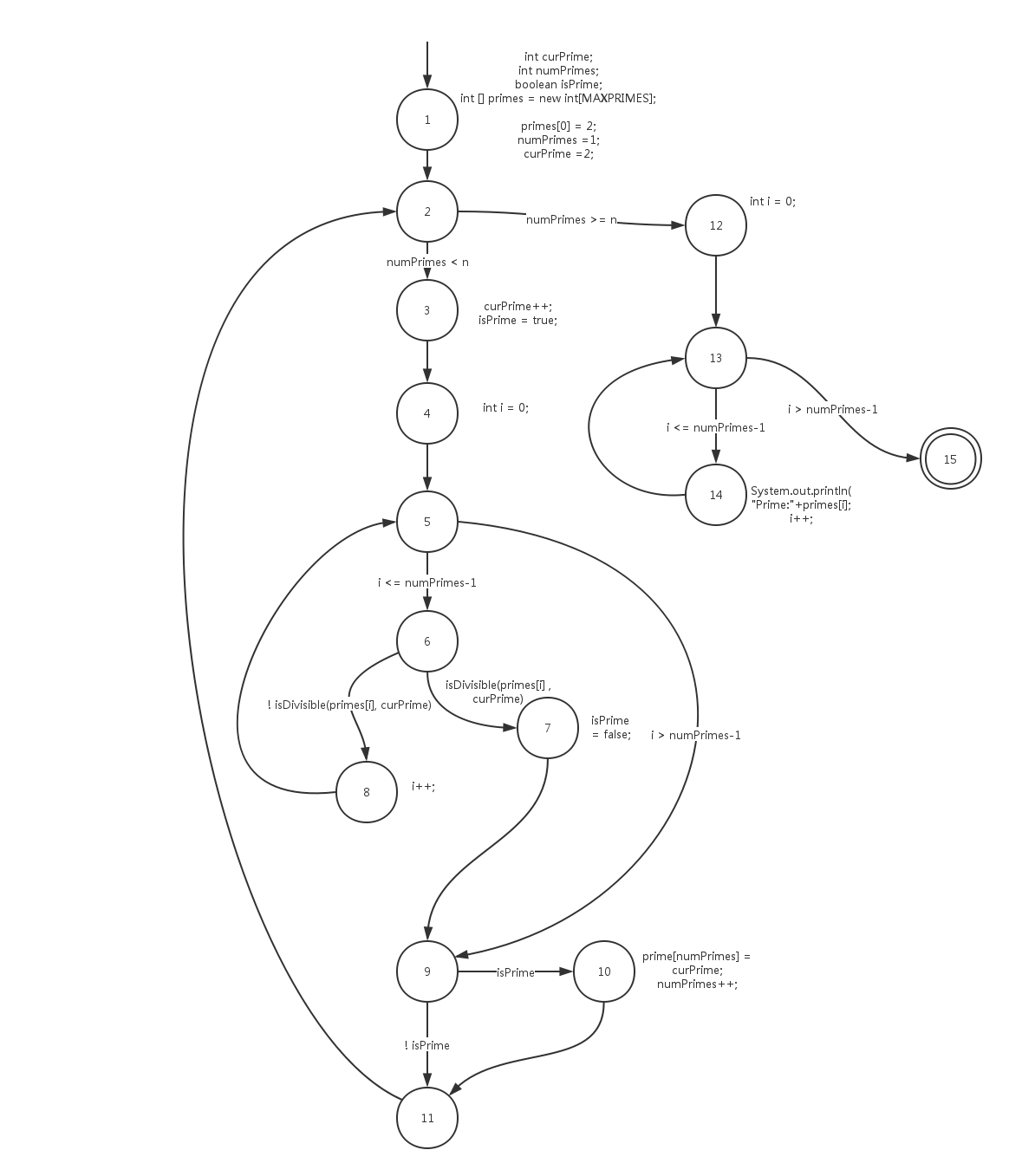本周的作业,是“软件测试基础”教材 ExerciseSection2.3 的课后习题。
题目要求,用下面的方法printPrimes()完成相应问题。 代码如下:
/******************************************************* * Finds and prints n prime integers * Jeff Offutt, Spring 2003 ******************************************************/ public static void printPrimes (int n) { int curPrime; // Value currently considered for primeness int numPrimes; // Number of primes found so far. boolean isPrime; // Is curPrime prime? int [] primes = new int [MAXPRIMES]; // The list of prime numbers. // Initialize 2 into the list of primes. primes [0] = 2; numPrimes = 1; curPrime = 2; while (numPrimes < n) { curPrime++; // next number to consider ... isPrime = true; for (int i = 0; i <= numPrimes-1; i++) { // for each previous prime. if (curPrime%primes[i]==0) { // Found a divisor, curPrime is not prime. isPrime = false; break; // out of loop through primes. } } if (isPrime) { // save it! primes[numPrimes] = curPrime; numPrimes++; } } // End while // Print all the primes out. for (int i = 0; i <= numPrimes-1; i++) { System.out.println ("Prime: " + primes[i]); } } // end printPrimes
(a) 为printPrimes()方法画控制流图。
(b) 考虑测试用例t1=(n=3)和t2=(n=5)。即使这些测试用例游历printPrimes()方法中相同的路径,它们不一定找出相同的错误。设计一个简单的错误,使得t2比t1更容易发现。
(c) 针对printPrimes(),找到一个测试用例,使得相应的测试路径访问连接while语句开始到for语句的边,而不用通过while循环体。
(d) 针对printPrimes()的图列举每个节点覆盖、边覆盖和主路径覆盖的测试需求。
首先,求解(a)。通过processon做出控制流图如下:

(b) 针对“数组越界”的错误,t2比t1更容易发现。
(c) 测试用例: n = 0 或 n = 1
(d) 点覆盖: {1,2,3,4,5,6,7,8,9,10,11,12,13,14,15}
边覆盖: {(1,2),(2,3),(2,12),(3,4),(4,5),(5,6),(6,7),(6,8),(7,9),(8,5),(9,10),(9,11),(10,11),(11,2),(12,13),(13,14),(13,15),(14,13)}
主路径覆盖: {(1,2,3,4,5,6,7,9,10,11),
(1,2,3,4,5,6,7,9,11),
(1,2,3,4,5,6,8),
(1,2,3,4,5,9,10,11),
(1,2,3,4,5,9,11),
(1,2,12,13,14),
(1,2,12,13,15),
(2,3,4,5,6,7,9,10,11,2),
(2,3,4,5,6,7,9,11,2),
(2,3,4,5,9,10,11,2),
(2,3,4,5,9,11.2),
(3,4,5,6,7,9,10,11,2,12,13,14),
(3,4,5,6,7,9,11,2,12,13,14),
(3,4,5,6,7,9,10,11,2,12,13,15),
(3,4,5,6,7,9,11,2,12,13,15),
(3,4,5,9,10,11,2,12,13,14),
(3,4,5,9,11,2,12,13,14),
(3,4,5,9,10,11,2,12,13,15),
(3,4,5,9,11,2,12,13,15),
(5,6,8,5),
(6,8,5,9,10,11,2,12,13,14),
(6,8,5,9,10,11,2,12,13,15),
(6,8,5,9,11,2,12,13,14),
(6,8,5,9,11,2,12,13,15),
(13,14,13),
(14,13,15)}
现在,对具体代码进行分析。代码选择上次测试三角形实验的代码。

该例子中,测试用例为:
(1.0, 1.0, 4.0), (10.0, 10.0, 10.0), (5.0, 5.0, 6.0), (3.0, 4.0, 5.0)
代码覆盖率为100%,如图所示。
具体代码已上传github,链接:https://github.com/CindyZJT/lab1